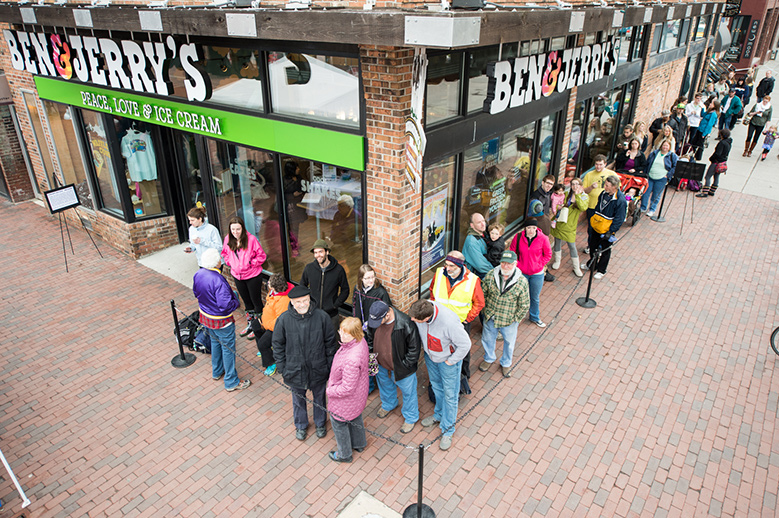What City Observatory did this week
1. The Dow of Cities. The most predictable feature of any media business report is a recitation of the daily movements of major stock indices, like the Dow Jones Industrial Average. The Dow is meant to use changes in prices to concisely convey the market’s sentiments about the outlook for the economy. At City Obsrervatory, we’ve suggested that the relative price that people are willing to pay for city homes compared to suburban ones functions as a kind of “Dow of Cities.” And based on home price data compiled by Fitch Investment Advisers, this market indicator is up sharply: prices for city homes have risen about 50 percent faster than for suburban homes since 2000, reflecting a growing demand for urban living–and a growing shortage of cities.
2. The Ben and Jerry’s crash course in transportation economics. Tuesday marked Ben and Jerry’s annual free cone day, where they give ice cream cones away to anyone who comes to one of their stores. People line up around the block to get “free” ice cream: exactly the way that we get lines of cars at rush hour, and for exactly the same reason: when something is under-priced, it is over-used, and in effect we end up rationing it inefficiently by patience, rather than price. As long as highway engineers pretend that every day is free cone day on urban roads, we’ll continue to have regular traffic congestion.
3. A critical look at suburban triumphalism. A lot has been made in the media lately about somewhat faster rates of population growth in suburban counties, and a slowdown of population growth in denser counties. Some are ready to proclaim the era of expanding urbanism over. We’re not: a close look at the data shows that city growth has accelerated compared to the last decade, and continues to be powered by the increasing movement of talented young workers to city centers and close-in neighborhoods. The growing price premium for urban housing shows just how robust that demand is, and why we need more housing, and more great urban neighborhoods to address our national shortage of cities.
Must read
1. Measuring Social Capital. Two decades ago, in his book “Bowling Alone,” Robert Putnam popularized the idea of social capital, the notion that widely shared norms of reciprocity and networks of loose ties underpin equity and economic success. The term has been easier to describe than to measure. A new report from the office of US Senator Mike Lee of Utah presents a set of state and county indicators intended to measure variations in regional social capital. The state measures are based on a rich array of survey data, mostly from the US census that looks at everything from family structure (single-parent households) and children’s television watching habits, to rates of voting and volunteering and the numbers of non-profit organizations in a community. Similar to Putnam’s original results, this index shows the strongest social capital in the center of the country, in a belt running from Wisconsin to Utah.
2. Would auctioning off higher density pay to fix New York’s transit problem? New York City faces two big problems: a chronic housing affordability crisis and an over-loaded and under-funded transit system. In The Atlantic, Reihan Salam sketches out a proposal to tackle both problems at once by having the city auction off the right to build to much higher densities. In “transit growth zones,” builders could pay a per square foot fee to build buildings taller than currently allowed by zoning. The author of the scheme, Manhattan Institute’s Alex Armlovich, estimates that it could produce more than 400,000 units of housing over a decade and and more than $50 billion to support subway costs. Salam also argues that more housing near transit would reduce displacement pressure in existing neighborhoods. The politics of such a proposal would be formidable, but like the debate around California’s SB 827, it’s the kind of game-changing discussion that’s worth having.
3. Rents are dropping in New York. Bloomberg reports that in all five boroughs, year-over-year median rents have fallen, by about 3.8 percent in Manhattan and by more than 6 percent in Brooklyn and Queens. The reason, per Bloomberg:
Property owners across the three boroughs are contending with an avalanche of new apartment supply, giving them no choice but to cut prices.
It’s not a sudden, spontaneous decline in landlord greed, it’s about supply and demand. Because prospective renters have choices (thanks to a growing supply of apartments), they have more ability to negotiate with landlords.
New knowledge
The counter-intuitive effects of “ban the box.” Many cities and states have adopted “ban the box” laws that prohibit employers from asking about whether prospective job applicants have ever been convicted of a crime. A National Bureau of Economic Research working paper looks at the effects of these requirements on crime rates. While “ban the box” seems like a simple and fair way of blocking discrimination, this evidence suggests that in the absence of direct information about prior criminal records, employers revert to other kinds of discrimination. The study finds that in jurisdictions that adopted ban the box, property crime rates for Hispanic offenders increased, while property crime rates for whites tended to decline. This evidence is consistent with employers discriminating against people of color in response to ban the box laws.
Do Ban the Box Laws Increase Crime? Joseph J. Sabia, Taylor Mackay, Thanh Tam Nguyen, Dhaval M. Dave, NBER Working Paper No. 24381
In the news
The Aspen Institute called our commentary “Ben and Jerry’s Crash Course on Transportation Economics” one of the five best ideas of the day on April 12.
Reihan Salam quotes City Observatory’s Joe Cortright in his article on an innovative idea for tackling New York City’s housing and transportation problems published in The Atlantic.




